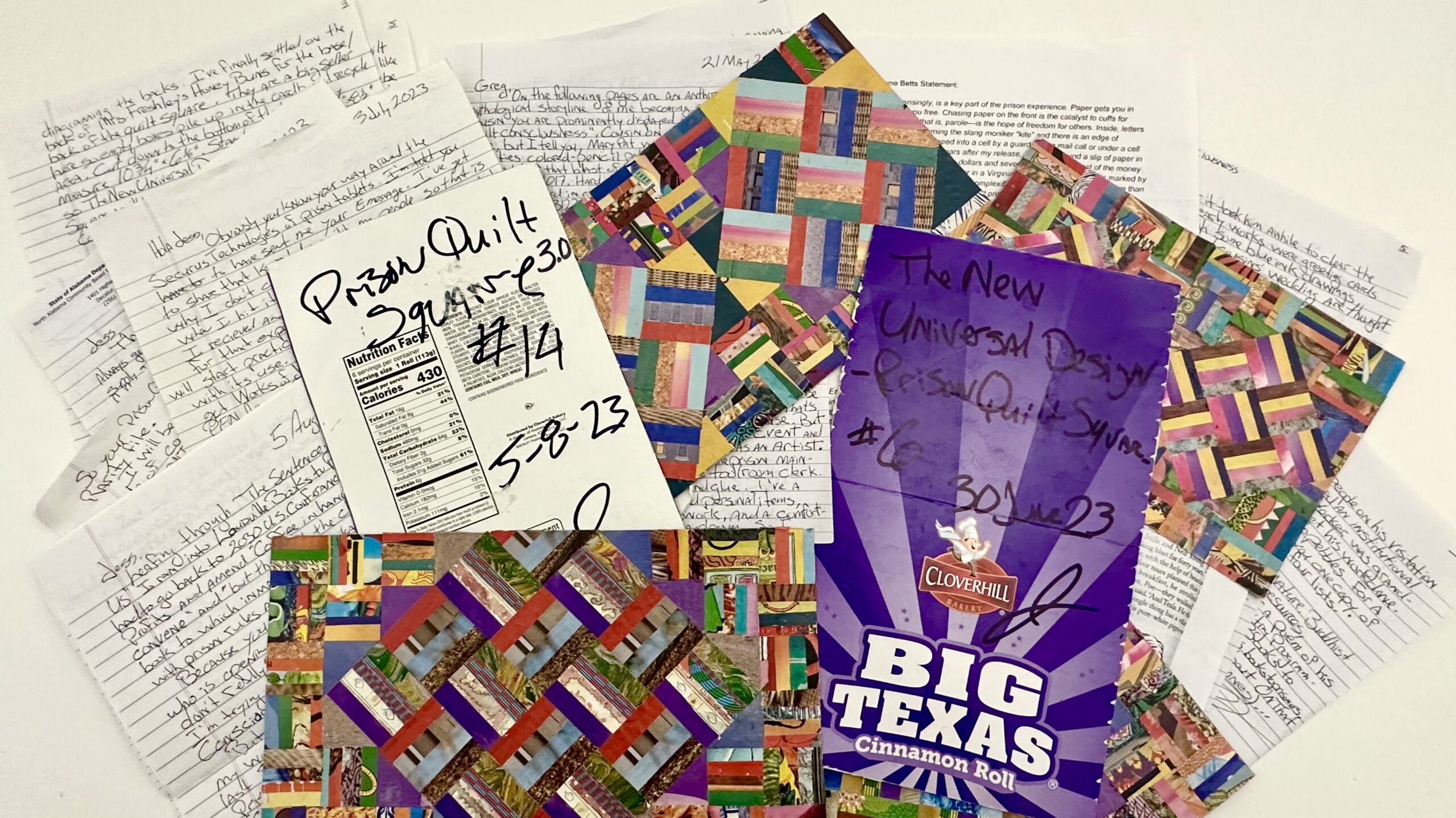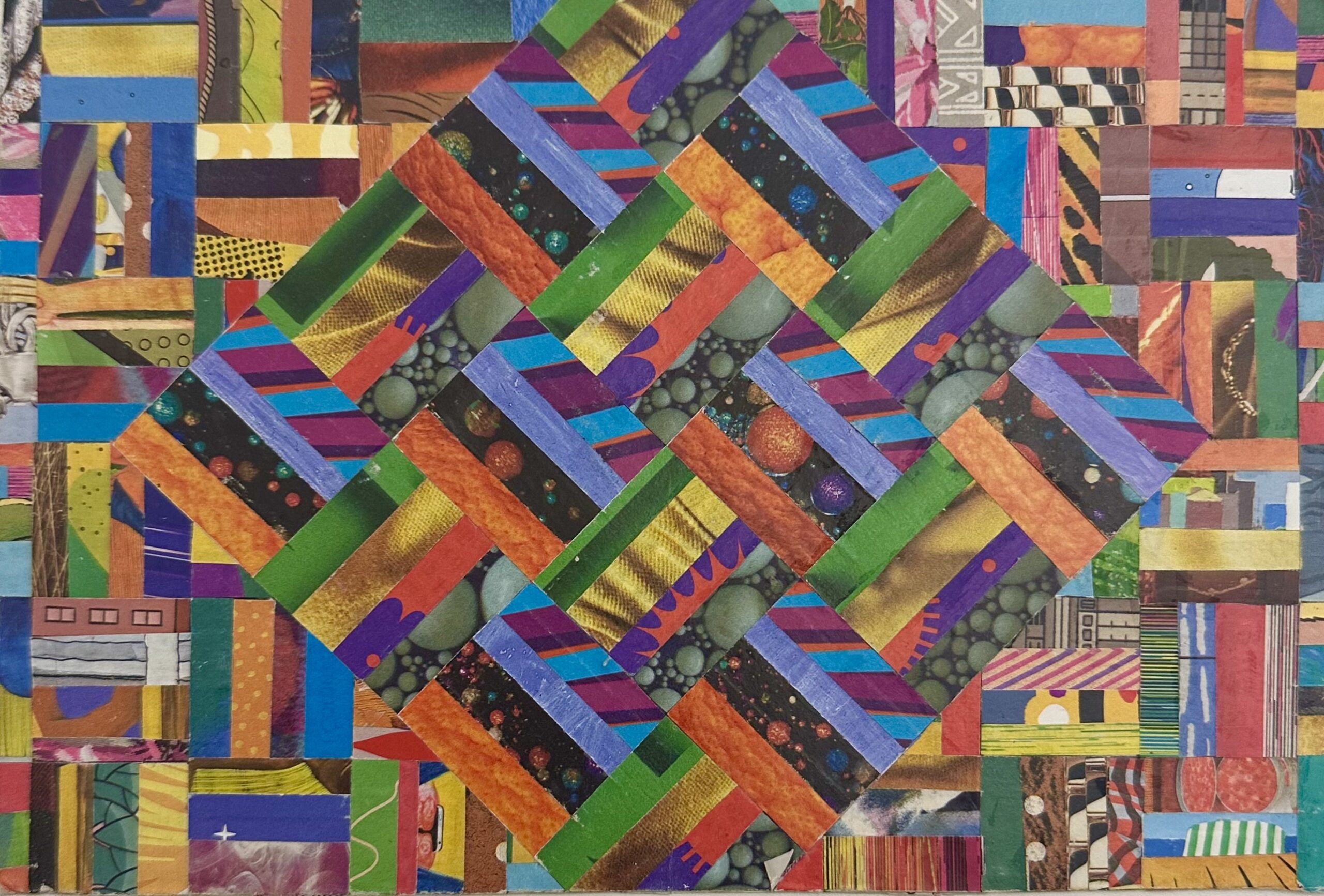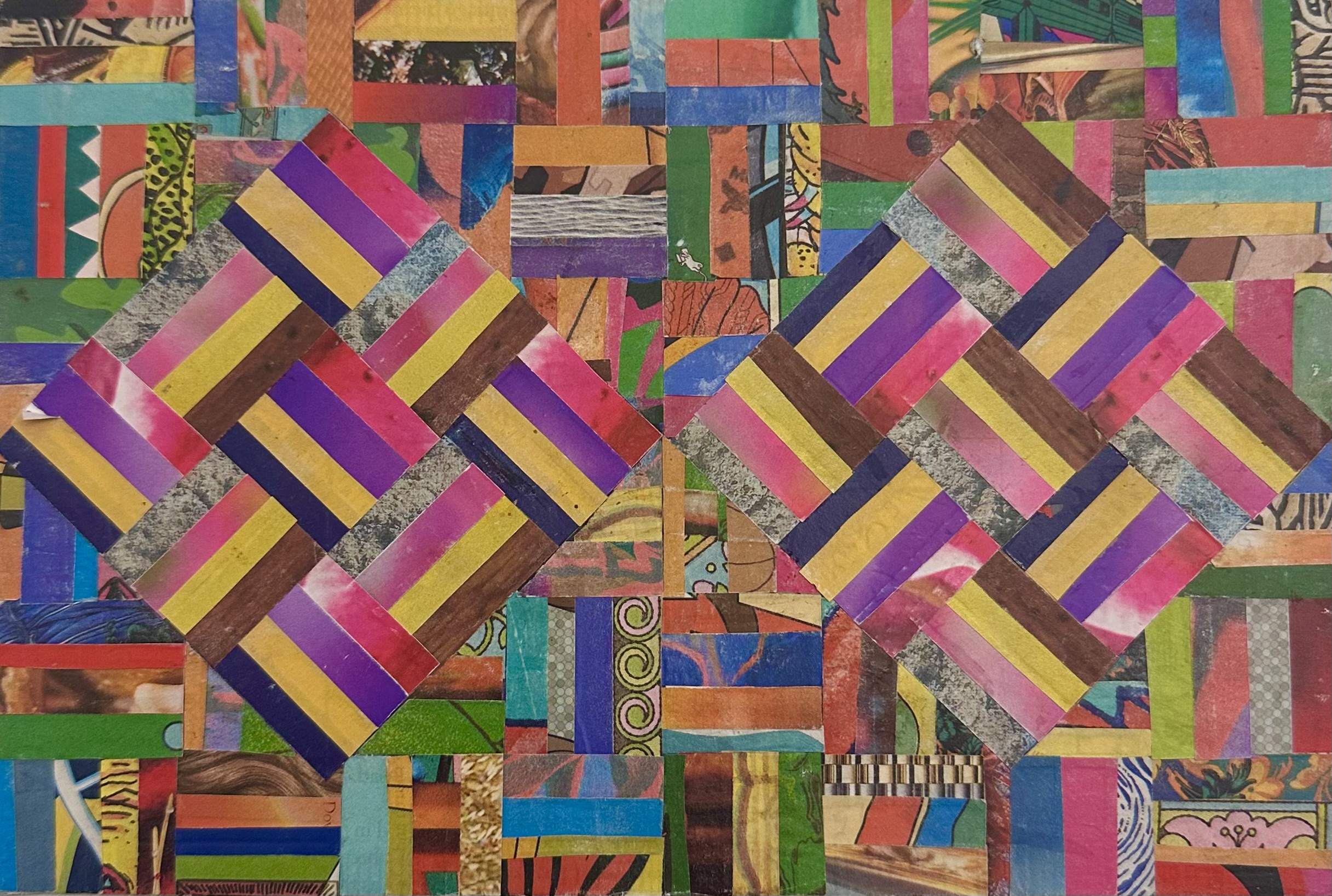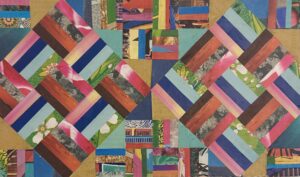Unsealed: On That Old Rock Pile Prison Quilt Project

Life behind prison walls is often dark, desolate, and dismal. Uniform colors are typically neutral or muted, access to natural light is scarce, and increasing mail digitization practices are erasing the color within envelopes, turning letters and photographs into grayscale, scanned versions.
But as the mail that arrives on my desk each day highlights, incarcerated individuals use the minimal resources at their disposal to preserve color, art, and beauty in their surroundings, disrupting the heavy bleakness of carceral atmospheres. The letters I receive are often adorned with detailed sketches, colorful pens and markers, and even full-page drawings that demonstrate the breadth of creativity buried within the shadows of carceral confinement.
Going through the daily mail pile one day, I noticed a large, yellow envelope from Jeff Elmore, who has cultivated a passion for collage work and paper-making during his time in an Alabama state prison. Jeff graciously sent me one of his original “paper quilt squares” in his initial correspondence. I was in awe at Jeff’s meticulous design, each magazine square so precisely cut and formed into a beautiful art piece. I wrote back to him, hoping to learn about the process of creating the quilt squares and his inspiration for doing so.
A few weeks later, three more original quilt squares arrived accompanied by a letter from Jeff. Everything in the package was produced on his work desk turned art studio, as his living dorm is too dark to see and his bottom-rack bed has no headroom for sitting up comfortably to write. Jeff explained how he started making quilt squares and his goals and aspirations for the broader project, which he named “On That Old Rock Pile Prison Quilt Project,” inspired by a lyric in Johnny Cash’s song, “Doin’ My Time”:
On this old rock pile with a ball and chain
They call me by a number, not a name, Lord, Lord
Gotta do my time, I gotta do my time
With an aching heart and worried mind
Jeff also included an excerpt from Reginald Dwayne Betts, which discusses the significance of paper itself in carceral spaces:
Paper, perhaps surprisingly, is a key part of the prison experience. Paper gets you in and sometimes gets you free. Chasing paper on the front is the catalyst to cuffs for many; making papers—that is, parole—is the hope of freedom for others. Inside, letters from family are lifelines, earning the slang moniker “kite” and there is an edge of exhilaration when a kite is slipped into a cell by a guard during mail call or under a cell door by another prisoner. For years after my release, I carried around a slip of paper in my wallet. A receipt for twenty-five dollars and seventy-one cent, the last of the money I’d earned working for 45 cent an hour in a Virginia prison. The experience is marked by paper. Transforming the paper into art complexifies the experience, makes it more than loss, more than the account for crimes and prison time that seem to stalk.
Through his Quilt Project and other creative endeavors, Jeff complexifies his own experience in prison, using artistic outlets to cultivate meaningful work and foster connections between the walls. Like his quilt squares, Jeff’s essay below pieces many components together, namely excerpts from letters written to me, his family, and members of various organizations, all in the mission of sharing his art with the world around him.
Jess Abolafia
Program Assistant, Prison and Justice Writing
On That Old Rock Pile Prison Quilt Project
Prison life is drudgery. One attempts to keep a positive attitude, exercise, and eat right with the goal of getting out relatively healthy. One also attempts to stay in touch with friends and family, in my case, by mail because I’m not a phone person. Enrolling in classes and programs also helps to keep your mind and spirit active. I spent the beginning of my sentence at Limestone Correctional Facility – Level 4, where I was enrolled in Horticulture Trade School. It was a good program run by a great instructor. I advanced through the program and became a tutor. So I had something to “write home” about.
In Alabama, when you are a year away from your first parole hearing and have been a good boy, they ship you to a Work Release Camp to finish out your sentence. Here, I’ve worked my way into an institutional job with a desk: the toolroom clerk in the prison maintenance department. With nothing interesting to write home about anymore, I struck out to create a good visual presentation, and collage became my modus operandi.
The toolroom office, located way off the beaten path and behind a steel mesh door, became my art studio. I had a cabinet to store books, supplies and personal items, a desk on which to lay out my designs, and a comfortable chair in which to daydream.

Jeff Elmore’s Universal Design (On That Old Rock Pile Prison Quilt Project)

Jeff Elmore’s New Universal Design (On That Old Rock Pile Prison Quilt Project)
With only magazine scraps, glue, and cardboard as my medium, I began to make my first collage quilts. My mother was a quilter, so I saw first hand how a fabric quilt was made. She made wall hangings in quilt patterns, and that was probably my inspiration. The first 45 original quilts I created, what I call my “Universal Design,” are two-sided and can fold in the middle like a greeting card. There is a large diamond shape on the inside and two smaller diamonds on the front and back. They are made of cut magazine scraps glued to Lipton Tea boxes, which have been unfolded. All of the cuts are made with a single razor blade popped out of a disposable razor and a plastic ruler obtainable at the prison store. The blade would cut into the plastic ruler, so I improvised with other straight-edges. My only magazine subscription was to The New Yorker. Luckily they came weekly, so I have a supply of color scraps to keep up with my demand.
By the end of 2020, two years after I first started my collage work, I began making quilts as my Christmas cards. Around that same time, I received a copy of Tom Robbins’s memoir, Tibetan Peach Pie, where I read Tom’s story of how he became Tom Robbins. I’m a prisoner behind the fence, and I only have so much ability to share my ideas. So you can imagine my delight upon seeing a PO Box address provided in the memoir’s preface. I decided to write to Tom in January 2021 and created a quilt to include in my letter. He sent me a response, which read “all the more so that your collage proves you’re doing something creative and interesting in your confinement. I urge you to persist.” I felt seen as a person, and this is when “On That Old Rock Pile Prison Quilt Project” began to form.
 Over time, I created an assembly line for my work process and made a template for speed-cutting my diamond color strips with the razor blade. I also developed two “New Universal Designs”: a large diamond, and a two-diamond pattern, reminiscent of both sides of the “Original Universal Design.” I’ve spent days measuring and diagramming different cardboard boxes to see what would be ideal for these creations. I finally settled on the back of Mrs. Freshly’s Honey Buns for the quilt square’s base. They are a big seller here, so empty boxes pile up in the cardboard recycle area. Cut down to the bottom of the box, they measure 10 3/4” x 6 1/2”. Standard paper is 11” x 8 1/2”, so the New Universal Design for the Prison Quilt Square will be copier friendly, a boon for potential collectors and traders.
Over time, I created an assembly line for my work process and made a template for speed-cutting my diamond color strips with the razor blade. I also developed two “New Universal Designs”: a large diamond, and a two-diamond pattern, reminiscent of both sides of the “Original Universal Design.” I’ve spent days measuring and diagramming different cardboard boxes to see what would be ideal for these creations. I finally settled on the back of Mrs. Freshly’s Honey Buns for the quilt square’s base. They are a big seller here, so empty boxes pile up in the cardboard recycle area. Cut down to the bottom of the box, they measure 10 3/4” x 6 1/2”. Standard paper is 11” x 8 1/2”, so the New Universal Design for the Prison Quilt Square will be copier friendly, a boon for potential collectors and traders.
In 2022, my desk was moved to the middle of the maintenance warehouse. As I was adjusting to my new studio, I continued to collage, and in my mind, the pieces I sent to my brothers and cousin could be put together in a more abstract way than my previous quilt projects.
I’m doing prison time, and I do not want that time to be wasted. Creating these quilts, to me, means creating a growing assemblage of awareness that prisoners are human, intelligent, and creative people. So I send quilts to organizations that recognize this, and also promote such organizations in my written narratives I often create to accompany my quilt squares. I would like to collaborate with prison benevolence organizations and maybe help them fundraise by offering them my work.
I do not frown upon copies of quilt squares. As the Grateful Dead did not discourage tapers, I do not discourage duplication. The real magic of my design comes from having multiples, getting the corners to form new squares of crazy quiltness. Being reversible, one gets double the pleasure, double the fun.
Imagine a person– brother, sister, cousin, or friend – receiving four squares a year as Christmas, Birthday, Summer Solstice, and Earth Day Cards. Two, four, eight, the personal quilt grows – times two, four, twenty years. Surely the idea of me wallpapering my outhouse with my quilts could be scaled up to billboard proportions. Granted I did not start making the quilts on my first day in this joint, but since I’ve been denied parole and have to wait another five years before reconsideration, my mind blooms with curiosity of creating art.
Most recently, I’ve been busy working with the Alabama Prison Arts + Education Project, which started its first class ever in Northern Alabama called “The Art of Paper and Collage.” I arrived front and center to get some college credit for my persistence in the paper arts. Now I’m hooked on making paper, two or three sheets every class. I pour a slurry of abaca pulp into a deckle box, then couch the pulp sheet onto felt to absorb some of the water. Since I have so much corrugated cardboard at my disposal, I’ve come up with a process of pressing my pulp sheet between it and roll pinning it with my forearm several times with a dry cardboard sponge, then I take it to my work station and press it between two ceramic tiles under a hundred pounds of dishwashing machine powder.
I think that with today’s technology, people could trade/collect my work by copy scans sent over the internet. Maybe over time, I can be the nerve center to where the laboriously handmade and beautifully detailed squares are housed, and people/organizations can share them with gallery owners, museum curators, artists, musicians, writers, and various friends of prisoners as listed in the “Mayan Messages” resource directory for prison residents. If an accumulation of quilt squares were to convene in one place—say, Hogan’s Fountain in Louisville, Kentucky on a specific day with a supply of thumb tacks and plywood—then people can spread the word about my On That Old Rock Pile Prison Quilt Project, and receive a quilt of their own. Wah-lah! A creative happening.
Jeff Elmore is currently incarcerated at North Alabama Community Work Center. Jeff completed a Certificate Program in Horticulture through Calhoun Community College. At 65 years old and halfway through a twenty year sentence, Jeff looks forward to gardening upon his release.
Jess Abolafia is the Prison and Justice Writing Program Assistant at PEN America. She graduated summa cum laude with a BA in English and African-American Studies from The College of New Jersey, where she also received an MA in English. Abolafia has instructed a writing-workshop at the only women’s maximum-security prison in New Jersey, empowering incarcerated women to use writing as a tool of healing and liberation. She is also working on several book projects with system-impacted individuals, including co-editing the memoir of an incarcerated woman sentenced to life in prison as a teenager, and compiling the paintings, drawings, and poems of an artist who found freedom through his artwork during nearly four decades of incarceration, including eight years on Death Row.






